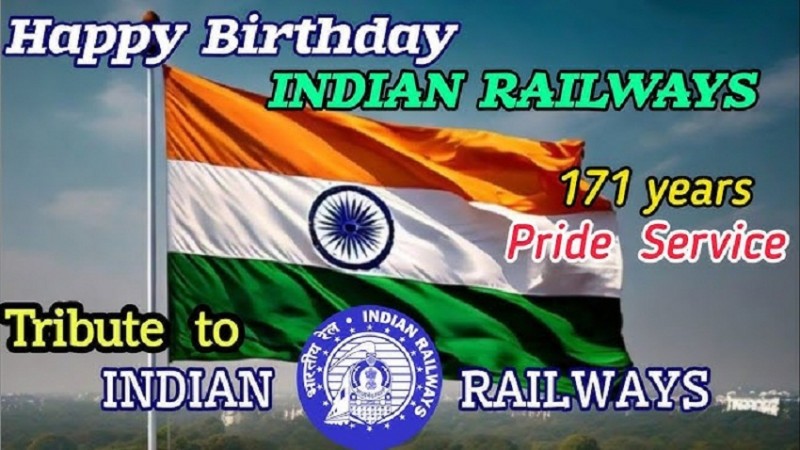
Indian Railways, one of the world's largest rail networks, has a fascinating history dating back to its start in 1853. Covering over 1.2 lakh kilometers across India, it serves millions of passengers every day with various services. Let's explore the remarkable journey of Indian Railways over the past 171 years.
Indian Railways marks April 16th as Rail Day, a tribute to the inaugural journey of the first passenger train in India, which embarked from Bori Bunder (now Mumbai CST) to Thane on that very date in 1853. This historic voyage, undertaken by the Great Indian Peninsula Railway, traversed 21 miles (33.8 km) in a remarkable 57 minutes, setting a precedent for the nation's burgeoning railway network. Railway Week, observed from April 10th to 16th, amplifies the significance of this milestone, commemorating the transformational role of railways in shaping India's connectivity and progress. Before India's independence, the railway system was managed by private entities, highlighting its evolution into a vital public service post-independence. Today, the Indian Railways stands as a colossal network, boasting expansive stations, administrative offices, and iconic bungalows dotting key railway junctions across the country, emblematic of its enduring legacy and monumental impact on Indian society.
Looking back at this significant milestone, a spokesperson from Central Railway (CR) told TOI, "171 years ago, the first train began its journey from Boribunder amidst a 21-gun salute and applause from the thousands gathered at the station." The idea of a railway system in British India was first suggested in 1832, but it wasn't until 1844 that private entrepreneurs were allowed to establish railway systems. The first train journey in India occurred on April 16, 1853, between Bombay (now Mumbai) and Thane, marking the start of a revolutionary transportation system.
Expansion and Growth
From the 1850s to the early 20th century, Indian Railways saw significant expansion, with new lines and companies formed across the country. The establishment of the Railway Board in 1901 marked a crucial moment in its governance.
Electrification and Advancement
Between 1925 and 1950, railway lines were electrified, and new technologies, including electric locomotives, were introduced. The first Railway budget was presented in 1925, reflecting the increasing importance of the railway network in India's development.
Reorganization and Modernization
In 1951, Indian Railways underwent reorganization into regional zones, leading to better management and efficiency. Over the years, various developments such as computerized ticketing, the introduction of new train services like Shatabdi Express, and electrification projects have propelled Indian Railways into the modern era.
Currently, Central Railway operates five suburban corridors, with services evolving from three-coach to up to 15-coach configurations. The introduction of AC suburban services further enhances passenger comfort and convenience, reflecting the railway's commitment to modernization and service excellence.
Recent Plans and Future Initiatives
Prime Minister Narendra Modi has unveiled ambitious plans to revolutionize rail transportation in India. With a focus on expanding Vande Bharat trains and introducing bullet train services, the aim is to enhance connectivity and propel India into the future of rail travel.
Expansion of Vande Bharat Trains
PM Modi pledges to expand Vande Bharat trains across the country, offering three different models: Vande Bharat Sleeper, Vande Bharat Chaircar, and Vande Bharat Metro. Since its inception in February 2019, Vande Bharat trains have symbolized modernization and efficiency in Indian Railways.
Introduction of Bullet Train Services
Highlighting ongoing work on the Mumbai-Ahmedabad High-Speed Rail Corridor, PM Modi announces plans to introduce bullet train services in north, east, and south India. Geotechnical investigations and construction activities are already underway, signaling progress towards a high-speed rail network.
Government's Commitment and Funding
The total cost of the Mumbai-Ahmedabad High-Speed Rail Corridor is estimated at Rs 1.08 lakh crore, with contributions from the Central government as well as the states of Gujarat and Maharashtra. This investment underscores the government's commitment to modernizing India's transportation infrastructure.
Future Prospects and Surveys
PM Modi emphasizes the importance of survey work for expanding bullet train services, signaling the government's proactive approach towards infrastructure development. With plans to enhance rail connectivity nationwide, India is poised for a transformative shift in its transportation landscape.
As Indian Railways celebrates its 171st anniversary, it continues to be a lifeline for millions of people across the country. From its humble beginnings to its current status as a symbol of progress and connectivity, Indian Railways remains an integral part of India's journey towards development and prosperity.
Indian Rail Transport Day 2024: Know These Lesser-known facts about Indian Railways